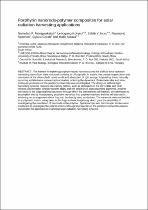 ResearchSpace
ResearchSpace
Porphyrin nanorods-polymer composites for solar radiation harvesting applications
JavaScript is disabled for your browser. Some features of this site may not work without it.
- ResearchSpace
- →
- Research Publications/Outputs
- →
- Journal Articles
- →
- View Item
| dc.contributor.author |
Mongwaketsi, NP

|
|
| dc.contributor.author |
Kotsedi, L

|
|
| dc.contributor.author |
Nuru, ZY

|
|
| dc.contributor.author |
Sparrow, R

|
|
| dc.contributor.author |
Garab, G

|
|
| dc.contributor.author |
Maaza, M

|
|
| dc.date.accessioned | 2015-08-19T11:07:01Z | |
| dc.date.available | 2015-08-19T11:07:01Z | |
| dc.date.issued | 2014-09 | |
| dc.identifier.citation | Mongwketsi NP, Kotsedi L, Nuru ZY, Sparrow R, Garab G, Maaza M. 2014. Porphyrin nanorods-polymer composites for solar radiation harvesting applications. Journal of Porphyrins and Phthalocyanines, Vol. 18, pp. 1145-1156 | en_US |
| dc.identifier.issn | 1088-4246 | |
| dc.identifier.uri | http://www.worldscientific.com/doi/abs/10.1142/S1088424614500941 | |
| dc.identifier.uri | http://hdl.handle.net/10204/8080 | |
| dc.description | Copyright: 2014 World Scientific Publishing. Due to copyright restrictions, the attached PDF file only contains the abstract of the full text item. For access to the full text item, please consult the publisher's website. The definitive version of the work is published in the Journal of Journal of Porphyrins and Phthalocyanines, Vol. 18, pp 1146-1154 | en_US |
| dc.description.abstract | The interest in exploring porphyrin-based nanostructures for artificial solar radiation harvesting stems from their structural similarity to chlorophylls. In nature, the precise organization and orientation of the chlorophylls result in efficient absorption of light energy. Inspired by these naturally occurring architectures relevant optical studies including the dynamics of intermolecular and intra-molecular processes of the porphyrin nanorods were investigated. The design of artificial light harvesting systems requires several key factors, such as absorption in the UV-visible and near-infrared wavelengths, energy transfer ability and the selection of light absorbing pigments. Another key factor is the organizational structure through which the components will interact. We attempted to accomplish this by incorporating porphyrin nanorods into polymer matrices and this will also aid in achieving an arrangement where they can be directly used as devices. The nanorods were embedded in a polymeric matrix, using latex technology and electrospinning which gave the possibility of investigating the orientation of nanorods in the polymer. Spectroscopic and microscopic studies were conducted to investigate the optical and morphological properties of the porphyrin nanorods-polymer composites for applications in artificial solar radiation harvesting systems. | en_US |
| dc.language.iso | en | en_US |
| dc.publisher | World Scientific Publishing | en_US |
| dc.subject | Porphyrin nanorods | en_US |
| dc.subject | Ionic self-assembly | en_US |
| dc.subject | Artificial light harvesting | en_US |
| dc.subject | Latex | en_US |
| dc.title | Porphyrin nanorods-polymer composites for solar radiation harvesting applications | en_US |
| dc.type | Article | en_US |
| dc.identifier.apacitation | Mongwaketsi, N., Kotsedi, L., Nuru, Z., Sparrow, R., Garab, G., & Maaza, M. (2014). Porphyrin nanorods-polymer composites for solar radiation harvesting applications. http://hdl.handle.net/10204/8080 | en_ZA |
| dc.identifier.chicagocitation | Mongwaketsi, NP, L Kotsedi, ZY Nuru, R Sparrow, G Garab, and M Maaza "Porphyrin nanorods-polymer composites for solar radiation harvesting applications." (2014) http://hdl.handle.net/10204/8080 | en_ZA |
| dc.identifier.vancouvercitation | Mongwaketsi N, Kotsedi L, Nuru Z, Sparrow R, Garab G, Maaza M. Porphyrin nanorods-polymer composites for solar radiation harvesting applications. 2014; http://hdl.handle.net/10204/8080. | en_ZA |
| dc.identifier.ris | TY - Article AU - Mongwaketsi, NP AU - Kotsedi, L AU - Nuru, ZY AU - Sparrow, R AU - Garab, G AU - Maaza, M AB - The interest in exploring porphyrin-based nanostructures for artificial solar radiation harvesting stems from their structural similarity to chlorophylls. In nature, the precise organization and orientation of the chlorophylls result in efficient absorption of light energy. Inspired by these naturally occurring architectures relevant optical studies including the dynamics of intermolecular and intra-molecular processes of the porphyrin nanorods were investigated. The design of artificial light harvesting systems requires several key factors, such as absorption in the UV-visible and near-infrared wavelengths, energy transfer ability and the selection of light absorbing pigments. Another key factor is the organizational structure through which the components will interact. We attempted to accomplish this by incorporating porphyrin nanorods into polymer matrices and this will also aid in achieving an arrangement where they can be directly used as devices. The nanorods were embedded in a polymeric matrix, using latex technology and electrospinning which gave the possibility of investigating the orientation of nanorods in the polymer. Spectroscopic and microscopic studies were conducted to investigate the optical and morphological properties of the porphyrin nanorods-polymer composites for applications in artificial solar radiation harvesting systems. DA - 2014-09 DB - ResearchSpace DP - CSIR KW - Porphyrin nanorods KW - Ionic self-assembly KW - Artificial light harvesting KW - Latex LK - https://researchspace.csir.co.za PY - 2014 SM - 1088-4246 T1 - Porphyrin nanorods-polymer composites for solar radiation harvesting applications TI - Porphyrin nanorods-polymer composites for solar radiation harvesting applications UR - http://hdl.handle.net/10204/8080 ER - | en_ZA |





